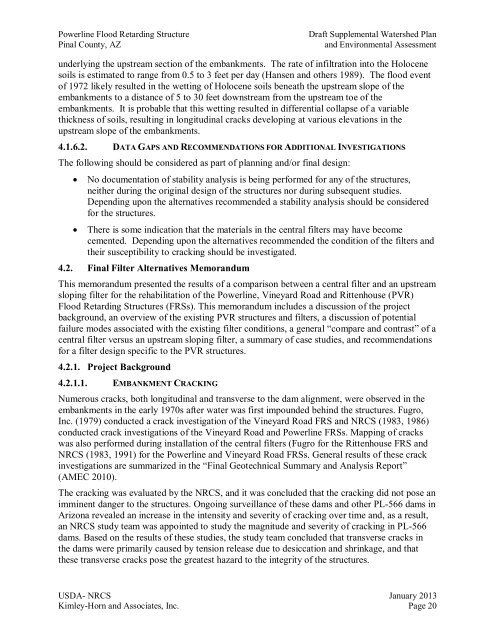Powerline Plan and Environ. Assessment Jan. 2013 - Flood Control ...
Powerline Plan and Environ. Assessment Jan. 2013 - Flood Control ...
Powerline Plan and Environ. Assessment Jan. 2013 - Flood Control ...
You also want an ePaper? Increase the reach of your titles
YUMPU automatically turns print PDFs into web optimized ePapers that Google loves.
<strong>Powerline</strong> <strong>Flood</strong> Retarding Structure<br />
Pinal County, AZ<br />
Draft Supplemental Watershed <strong>Plan</strong><br />
<strong>and</strong> <strong>Environ</strong>mental <strong>Assessment</strong><br />
underlying the upstream section of the embankments. The rate of infiltration into the Holocene<br />
soils is estimated to range from 0.5 to 3 feet per day (Hansen <strong>and</strong> others 1989). The flood event<br />
of 1972 likely resulted in the wetting of Holocene soils beneath the upstream slope of the<br />
embankments to a distance of 5 to 30 feet downstream from the upstream toe of the<br />
embankments. It is probable that this wetting resulted in differential collapse of a variable<br />
thickness of soils, resulting in longitudinal cracks developing at various elevations in the<br />
upstream slope of the embankments.<br />
4.1.6.2. DATA GAPS AND RECOMMENDATIONS FOR ADDITIONAL INVESTIGATIONS<br />
The following should be considered as part of planning <strong>and</strong>/or final design:<br />
<br />
<br />
No documentation of stability analysis is being performed for any of the structures,<br />
neither during the original design of the structures nor during subsequent studies.<br />
Depending upon the alternatives recommended a stability analysis should be considered<br />
for the structures.<br />
There is some indication that the materials in the central filters may have become<br />
cemented. Depending upon the alternatives recommended the condition of the filters <strong>and</strong><br />
their susceptibility to cracking should be investigated.<br />
4.2. Final Filter Alternatives Memor<strong>and</strong>um<br />
This memor<strong>and</strong>um presented the results of a comparison between a central filter <strong>and</strong> an upstream<br />
sloping filter for the rehabilitation of the <strong>Powerline</strong>, Vineyard Road <strong>and</strong> Rittenhouse (PVR)<br />
<strong>Flood</strong> Retarding Structures (FRSs). This memor<strong>and</strong>um includes a discussion of the project<br />
background, an overview of the existing PVR structures <strong>and</strong> filters, a discussion of potential<br />
failure modes associated with the existing filter conditions, a general “compare <strong>and</strong> contrast” of a<br />
central filter versus an upstream sloping filter, a summary of case studies, <strong>and</strong> recommendations<br />
for a filter design specific to the PVR structures.<br />
4.2.1. Project Background<br />
4.2.1.1. EMBANKMENT CRACKING<br />
Numerous cracks, both longitudinal <strong>and</strong> transverse to the dam alignment, were observed in the<br />
embankments in the early 1970s after water was first impounded behind the structures. Fugro,<br />
Inc. (1979) conducted a crack investigation of the Vineyard Road FRS <strong>and</strong> NRCS (1983, 1986)<br />
conducted crack investigations of the Vineyard Road <strong>and</strong> <strong>Powerline</strong> FRSs. Mapping of cracks<br />
was also performed during installation of the central filters (Fugro for the Rittenhouse FRS <strong>and</strong><br />
NRCS (1983, 1991) for the <strong>Powerline</strong> <strong>and</strong> Vineyard Road FRSs. General results of these crack<br />
investigations are summarized in the “Final Geotechnical Summary <strong>and</strong> Analysis Report”<br />
(AMEC 2010).<br />
The cracking was evaluated by the NRCS, <strong>and</strong> it was concluded that the cracking did not pose an<br />
imminent danger to the structures. Ongoing surveillance of these dams <strong>and</strong> other PL-566 dams in<br />
Arizona revealed an increase in the intensity <strong>and</strong> severity of cracking over time <strong>and</strong>, as a result,<br />
an NRCS study team was appointed to study the magnitude <strong>and</strong> severity of cracking in PL-566<br />
dams. Based on the results of these studies, the study team concluded that transverse cracks in<br />
the dams were primarily caused by tension release due to desiccation <strong>and</strong> shrinkage, <strong>and</strong> that<br />
these transverse cracks pose the greatest hazard to the integrity of the structures.<br />
USDA- NRCS <strong>Jan</strong>uary <strong>2013</strong><br />
Kimley-Horn <strong>and</strong> Associates, Inc. Page 20













